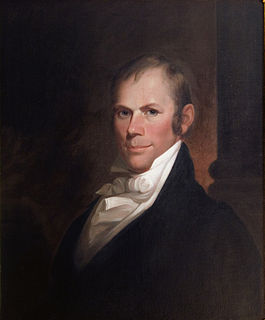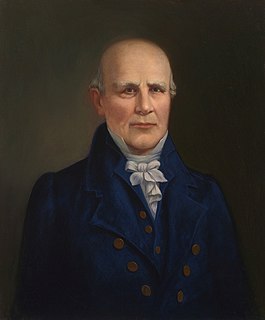Related Research Articles

Tufts University is a private research university on the border of Medford and Somerville, Massachusetts. It was founded in 1852 as Tufts College by Christian universalists who sought to provide a nonsectarian institution of higher learning. Tufts remained a small New England liberal arts college until the 1970s, when it transformed into a large research university offering several doctorates; it is classified as a "Research I university", denoting the highest level of research activity. In 2021, Tufts became a member of the Association of American Universities, a selective group of 64 leadings research universities in North America. The university is known for its internationalism, study abroad programs, and promoting active citizenship and public service across all disciplines.

The 1820 and 1821 United States House of Representatives elections were held at various dates in different states between July 1820 and August 1821 as President James Monroe won reelection unopposed.

The 1816 and 1817 United States House of Representatives elections were held at various dates in different states between April 1816 and August 1817.

The 1810 and 1811 United States House of Representatives elections were held at various dates in different states between April 1810 and August 1811 during President James Madison's first term.

The 1804 and 1805 United States House of Representatives elections were held at various dates in each state between April 24, 1804 and August 5, 1805. The Congress first met on December 2, 1805. The elections occurred at the same time as President Thomas Jefferson's re-election.
The Tufts Jumbos football program represents Tufts University in the sport of American football. The team competes in Division III of the National Collegiate Athletic Association (NCAA) and the New England Small College Athletic Conference (NESCAC). The team's head coach is Jay Civetti, who has led the Jumbos since 2011.
The 1804 and 1805 United States Senate elections were elections that expanded the Democratic-Republican Party's overwhelming control over the United States Senate. The Federalists went into the elections with such a small share of Senate seats that even if they had won every election, they would have still remained a minority caucus.
The 1806 and 1807 United States Senate elections were elections that had the Democratic-Republican Party increase its overwhelming control of the Senate by one additional Senator. The Federalists went into the elections with such a small share of Senate seats that even if they had won every election, they would still have remained a minority caucus. As it was, however, they lost one of the two seats they were defending and picked up no gains from their opponents.
The 1808 and 1809 United States Senate elections were elections that had the Federalist Party gain one seat in the United States Senate, and which coincided with the 1808 presidential election. The Federalists had gone into the elections with such a small share of Senate seats that even if they had won every election, they would have still remained a minority caucus.
The 1810 and 1811 United States Senate elections were elections that had the Democratic-Republican Party maintain their majority in the United States Senate. The minority Federalists had gone into the elections with such a small share of Senate seats that, had they won all of the elections, they would still not have reached a majority.
The 1812 and 1813 United States Senate elections were elections that, coinciding with President James Madison's re-election, had the Democratic-Republican Party lose two seats but still retain an overwhelming majority in the United States Senate. As in recent elections, the minority Federalists had gone into the elections with such a small share of Senate seats that if they had won every one of the elections, they would still not have controlled a majority.
The 1814 and 1815 United States Senate elections were elections that had the Democratic-Republican Party lose a seat but still retain an overwhelming majority in the United States Senate. Unlike in recent elections, the minority Federalists had gone into the elections with a chance of regaining their long-lost majority had they swept almost all the seats. However, only one seat switched parties. Two seats held by Democratic-Republicans were left unfilled until long after the next Congress began.
The 1816 and 1817 United States Senate elections were elections for the United States Senate that had the Democratic-Republican Party gain a net of two seats from the admission of a new state, and which coincided with the presidential election.
The 1818 and 1819 United States Senate elections were elections for the United States Senate that had the Democratic-Republican Party gain two seats. The Federalists had only three seats being contested, of which they lost two and the third was left vacant due to a failure to elect.
The 1802 and 1803 United States Senate elections were elections for the United States Senate which resulted in the Democratic-Republican Party maintaining and expanding their majority of seats.
The 1800 and 1801 United States Senate elections were elections for the United States Senate that, coinciding with their election to the White House, also led to the Democratic-Republican Party taking control of the United States Senate. Although the Federalists began the next (7th) Congress with a slim majority, they lost their majority shortly thereafter due to mid-year special elections.
The 1798 and 1799 United States Senate elections were held at the middle of President John Adams's administration and had no net change in political control of the Senate.
The 1796 and 1797 United States Senate elections were elections for the United States Senate which, coinciding with John Adams's election as President, had the ruling Federalist Party gain one seat.
The 1794 and 1795 United States Senate elections were elections that had the formation of organized political parties in the United States, with the Federalist Party emerging from the Pro Administration coalition, and the Democratic-Republican Party emerging from the Anti-Administration coalition.
The 1824 and 1825 United States Senate elections were elections for the United States Senate that saw the Jacksonians gain a majority over the Anti-Jacksonian National Republican Party.
References
- ↑ "Tufts Digital Library". dl.tufts.edu.